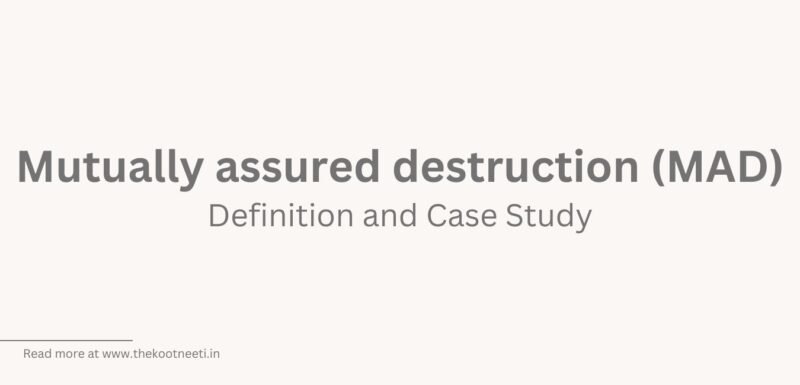Mutually assured destruction (MAD): Definition and Case Study

Mutually assured destruction (MAD) is a doctrine of military strategy and national security policy in which a full-scale use of nuclear weapons by two or more opposing sides would effectively result in the destruction of both the attacker and the defender. The doctrine is based on the premise that the use of nuclear weapons by one side would result in retaliation with nuclear weapons by the other side, leading to a catastrophic outcome for both sides.
The concept of mutually assured destruction was developed during the Cold War as a deterrent to prevent the use of nuclear weapons by either the United States or the Soviet Union. The doctrine was based on the idea that the possession of a large and effective nuclear arsenal by both sides would make the use of nuclear weapons by either side too risky, as it would result in the destruction of both sides.
Although mutually assured destruction was successful in preventing the use of nuclear weapons during the Cold War, it has been criticized for relying on the threat of catastrophic destruction and for potentially increasing the risk of a nuclear conflict.
Case Study
A case study of mutually assured destruction might involve analyzing a specific historical or contemporary instance in which MAD played a significant role in shaping international relations. Some possible examples might include:
- The role of MAD in the Cold War between the US and the Soviet Union
- The role of MAD in contemporary relations between the US and Russia
- The role of MAD in shaping the international relations of other nuclear-armed states, such as China, India, and Pakistan
Sample Study – Role of MAD in the Cold War between the US and Soviet Union
The Cold War was a period of intense ideological and military rivalry between the United States and the Soviet Union that lasted from the late 1940s to the early 1990s. One of the central features of the Cold War was the concept of mutually assured destruction (MAD), which was based on the idea that the prospect of a full-scale nuclear exchange between the two superpowers would deter either side from launching a nuclear attack.
The development of MAD was closely tied to the nuclear arms race between the US and the Soviet Union. As both sides developed increasingly sophisticated and powerful nuclear arsenals, the prospect of a devastating nuclear exchange became a real possibility. In this context, MAD emerged as a way to ensure that neither side would be willing to risk such an exchange.
The MAD doctrine was based on the idea that each side had enough nuclear weapons to inflict unacceptable damage on the other, even if it suffered a surprise attack. This meant that the prospect of a full-scale nuclear exchange would be so catastrophic for both sides that it would deter either side from launching a first strike.
In practice, MAD played a significant role in shaping the international relations of the US and the Soviet Union during the Cold War. The doctrine helped to prevent a direct military confrontation between the two sides and contributed to a relative stability in the international system. However, MAD also had its limitations and risks. The possibility of a nuclear exchange due to misperception or accident remained a constant concern, and the arms race associated with MAD put a strain on both sides’ economies and contributed to global tensions.
The role of MAD in the Cold War between the US and the Soviet Union was complex and multifaceted. While it helped to prevent a direct military confrontation between the two sides, it also carried significant risks and contributed to global tensions. As the Cold War came to an end and the international system underwent significant changes, the role of MAD in international relations also evolved.
How to conduct a case study?
To conduct a case study on mutually assured destruction, you might consider the following steps:
- Identify the specific instance of MAD that you want to study.
- Research the historical and political context surrounding the MAD doctrine. This might include examining the motivations and goals of the parties involved, the broader geopolitical context in which MAD played a role, and any relevant technological or military developments.
- Analyze the role and impact of MAD in shaping the actions and relations of the parties involved. This might include examining how MAD affected decision-making, communication, and the resolution of conflicts or crises.
- Consider the broader implications of the case study for our understanding of international relations, conflict, and deterrence.
- Evaluate the effectiveness of MAD as a deterrent and the potential drawbacks and risks associated with the doctrine.


















